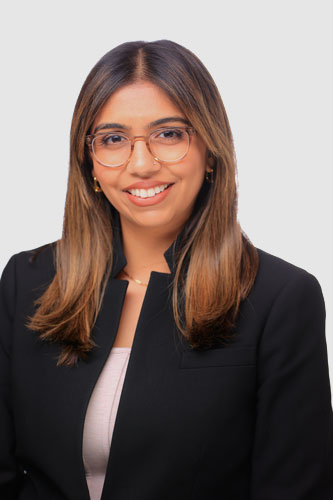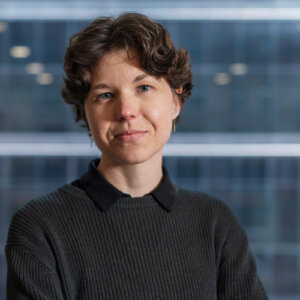Water Champion Chat:
Kalindi Parikh
In May 2024, MPC hosted A Vision for Water: Planning for Abundance and Scarcity in Illinois, convening leaders from across the region to build capacity and collaboration in the water sector. One of the water champions spearheading the conversation during our panel was Kalindi Parikh. As Strategy Director at Current, Kalindi advances innovation, environmental justice, and inclusive economic development in the water sector.
Today, we’re checking back in with Kalindi to see how her work has evolved and learn more about water happenings through the lens of Current’s work. We also discuss the plan for a quantum park, a major lakefront development on Chicago’s southeast side. This park will have implications for our region’s water stewardship, as emerging quantum computer technology is likely to use a large amount of water for cooling its equipment.

Can you tell us about who you are and what you do at Current?
My background is in economic development and urban planning. As Strategy Director for Current, my job is to integrate our work across a large variety of different interests and sectors. Current works to enable the kinds of scientific advancements through R&D that we need to solve our world’s pressing water challenges, and supports technologies coming out of the lab and into the market. Thinking about people and opportunity, we build the kind of workforce and entrepreneurship systems to ensure that these investments benefit people who are reflective of our communities, especially people who have been most underrepresented in the water field.
Current is the lead organization on Great Lakes ReNEW, which is a six-statewide coalition that recently won a National Science Foundation Regional Innovation Engine award for up to $160 million over 10 years, to advance those priorities with a large cross-sector partnership.
Are there any ideas that stuck with you from MPC’s Vision for Water event?
Our breakout group spent a lot of time talking about workforce development. Chicago Department of Water Management Commissioner Randy Conner participated alongside workforce organizations and engineering firms, which was really exciting for me as an attendee. It was encouraging to see the group discuss issues like lead service line replacement and other big infrastructure challenges. That conversation has continued to inform the organizing work we’re doing with MPC, Elevate and HIRE360 around lead service line replacement. We’ve all been asking, how do we support better collaboration across sectors to get the work done?
Has your work changed or evolved since then? Are there any new focuses coming into view for you in 2025?
I couldn’t answer a question at the event the way I wanted to at the time, because it was something we hadn’t announced yet. It was a question about how we engage industry. At the time, what I could say was that we were working with water-using industry to better define water stewardship, and that we wanted to balance water as a business attraction strategy with attracting responsible, forward-thinking water users. That we want the best-in-class industry here, leading the charge on water innovation and better water practices nationally and globally.
What I can say now is that we have been able to launch the Current Industry Consortium, which is doing just that. It’s bringing a set of heavy water-using industries with three founding members from across the food and beverage, energy, and manufacturing sectors to the table to help us define those needs up front, and tell us about their big water challenges. And now are we actually using that information to drive not only our research priorities but also our workforce priorities.
Are there connections that don’t tend to happen on a regular basis in the water sector that you want to be building and maintaining?
We were actually just reached out to this past week—there was a Forbes article about new connections between the National Science Foundation and unions. It made me think about how unlikely of a partnership the AFL-CIO and the NSF are, and yet they just signed an MOU recently to better support infusing workforce programs, especially those within trades and labor, with emerging science, and that’s really cool! To me, that embodies what we’re trying to do with our NSF engine: to not only explore partnership opportunities between trades-recognized workforce providers and utilities—but also to ask how we can include emerging science around things like new regulations around PFAS, for example. Some of the researchers in our network are leading that charge, and our work is to build unlikely dream teams.
What do you know about the implications of the planned quantum park for our region—for the regional economy, for the residents of the surrounding neighborhoods, and for our water? How does it relate to your work at Current?
If we’re not intentional about how we welcome this facility to our region, we stand the risk of harming very important natural resources. We want to elevate industry leaders in our region that are championing water stewardship, and leverage innovative water technologies to help them do that. Ideally, quantum computing and other kinds of high-performance computing can really elevate our ability to solve water challenges. Some of the researchers in our network have talked about it as a tool they can use to create better solutions.
To get this right, we want quantum companies to be engaged and participate in important conversations about water stewardship and also think about the connections to community and economic opportunity. There are huge opportunities to think about workforce development connections, STEM education for K-12 students, as well as other kinds of economic opportunity.
I think of this quantum site—as well as other major developments—as big players who should also be helping us design our research and workforce agendas. They should be at the table with Current and other civic organizations so that we can problem-solve and identify opportunity together.
What’s your Vision for Water for Chicago and Illinois?
I think we need to think about ourselves as a big, collaborative region. On an international stage, people don’t often differentiate between Chicago and our neighboring cities, so we really need to be thinking about this as a Great Lakes economy opportunity.
My vision for the Great Lakes region is that we become globally recognized as the place to go for water innovation, and we’re solving problems that we have at home and the problems that the world experiences. Because of our diverse mix of assets and leadership—incredible research universities and national labs, the accelerators, incubators, venture capital, workforce organizations, nonprofits, industry—I think we can become a global hub for solving water challenges in a really interdisciplinary way.
Is there anything else you’d like to add?
I think there’s a lot we can learn from other parts of the country too, and I do want to make sure Chicago always has its ear to the ground. One example of that: Milwaukee is doing this awesome nation-leading water pre-apprenticeship program with Wisconsin Regional Training Partnership (WRTP) which is their labor and trades recognized workforce provider, partnering with their water reclamation district. That is so cool—how can we think of ourselves as a place to scale or replicate that?
This interview has been lightly edited for length and clarity.
